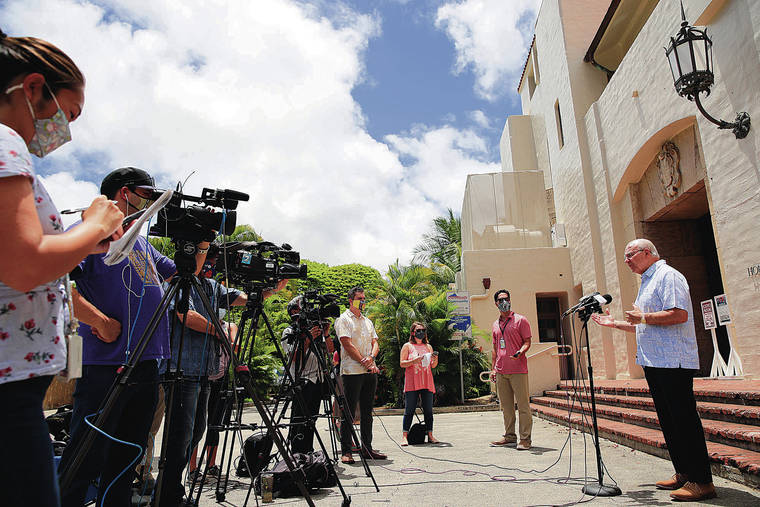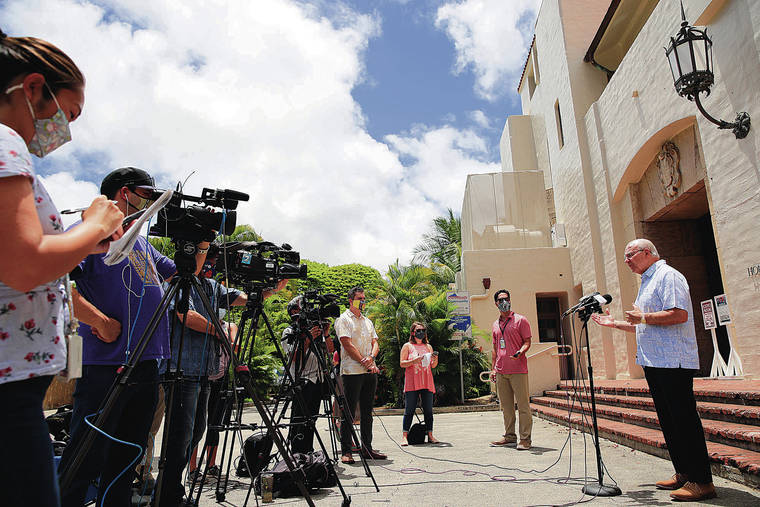

Oahu has moved to Tier 4 of its reopening plan, but it likely will be several more months until people will be able to dance to their favorite mainland bands in concert.
Mayor Rick Blangiardi announced Friday that Honolulu would move to Tier 4 of its reopening plan immediately following the city achieving a vaccination rate of over 50%.
“We’re at that point in time when we still continue each and every day to have the welfare and the safety and the health of our people as a top priority,” he said.
The move to Tier 4 allows for social gatherings of up to 25 people outdoors and 10 people indoors. Organized indoor sports can resume with spectators at 33% capacity. Outdoor weddings are allowed to host up to 200 people. Road races and triathlons also will be allowed with a permit.
The two most significant changes is the reopening of “social establishments” such as nightclubs and karaoke, and indoor events such as concerts and conventions at 50% capacity. Outdoor events will be allowed to open at 67% capacity. However, those who want to be admitted must show the business a proof of full vaccination or have tested negative for COVID-19 within the past 48 hours.
Outdoor events will be allowed to operate at 33% capacity without having to check patrons’ vaccination status or test results.
Scarlet, a downtown nightclub, has been closed since July but will reopen June 25 following the city’s announcement of moving to Tier 4.
Scarlet, the only gay dance club in Hawaii, is reopening on a culturally significant day, said owner Robbie Baldwin.
“We are going to open Friday, June 25, for Stonewall and Pride weekend,” he said.
Baldwin is referencing the significant time for gay liberation following a police raid in June 1969 at the Stonewall Inn in New York that sparked resistance from the LGBTQ community and led to several days of demonstrations.
“I feel that our customers have lost quite a bit,” Baldwin said.
“I think they’re all very excited to be able to get back together and watch drag shows and do all the things we were able to do pre-pandemic.”
People will be able to dance with each other again but will be required to wear a mask if they are not actively drinking.
Scarlet is handling reopening similarly as Chicago clubs where patrons show a physical vaccination card, a photocopy of it or a picture on their phone. It will be verified in the same way that IDs are checked to ensure people are of drinking age.
Blangiardi said the city will operate on a “trust system” to ensure that businesses are checking for vaccination cards or a proof of a negative COVID-19 test.
“We’re just going to trust in businesses,” he said.
“The one thing that we will do if suddenly people were just be totally in violation of the rules, if there’s a cluster or something happens, we’ll close it down.”
However, it’s unlikely that outdoor and indoor events, especially concerts featuring popular mainland acts, will be able to resume as quickly as nightclubs, said Rick Schneider, CEO of Events International Inc. and chairman of the political action committee of the Hawaii Events Coalition.
“Because there’s a restriction in capacity, it’s in many cases not profitable for a promoter to do a concert,” he said.
“So even though it does open things up, it’s not going to be everything, and unfortunately, the restrictions make it unlikely that we’re going to see too many.”
The issue Schneider described is that many states already have opened up and tours already have started booking. It also often takes between three and 12 months to plan a concert event.
“We’re not like a restaurant or a retail store where you can open your doors, work with less people to serve less people and have customers the next day,” he said.
“So if tomorrow they decided they’re going to open up everything, as an industry we’re not going to recover for another six months at the earliest … and there are a lot of companies that are just hanging on by a thread.”
The Hawaii Events Coalition’s survey of event companies shows that the average business’s loss between 2019 and 2020 was 92%.
He said it’s unlikely that local acts will benefit from mainland artists not coming to Hawaii, because the local talent may not be able to draw crowds large enough to pay for a show here, either. The added COVID-19 mitigation efforts have only increased the cost to put on an event, which means the price will also likely be passed on to the consumer with higher ticket prices.
Schneider has been working on a model to have concerts modeled on the Staples Center in Los Angeles where people with a proof of vaccination would be admitted and those who do not will have to take a rapid test on the event premises, produce a negative result and present it before entering.
“We have a provider that these tests will cost somewhere in the neighborhood of $25 to $40 per ticket per person,” he said.
“If they need to test, they will have to pay that additional fee.”
Another issue with attracting mainland talent to Hawaii is the COVID-19 restrictions in Asia.
“If they were going to Asia, they would stop here, then go to Japan or go to the Philippines or wherever,” Schneider said.
“But without that travel happening now, there’s that cutoff.”
He said bands are able to make much more of a profit in mainland cities because they can drive all of their performance gear in a large semi-truck. Hawaii’s event industry has been able to acquire enough equipment to put on a show through renting equipment, but that makes it more challenging for artists to perform here — and a reason for the larger price tag to attend events happening in Hawaii.
Schneider said that BAMP Projects has booked a couple of shows with comedians, which are easier to set up and lower-cost. Other promoters are looking to try to make arrangements for shows in the second half of the year.
However, one of the most devastating impacts of the COVID-19 shutdown, Schneider said, is the loss of trained workers who have moved to the mainland because they could not afford to stay here.
“The end result may be that some mainland company is going to come in and start doing the work because they have deep pockets, and they’ll just sort of take over,” he said.
“We’ll lose the real local connection and the local flavor of how we do business.”
Blangiardi said restrictions may be further loosened if Oahu is able to reach a vaccination rate of 60%, which could happen by early July.
He also said the tier system could be eliminated if 70% of the island was vaccinated. However, it is still being determined whether that number is reachable as many people are still hesitant to receive the vaccine.